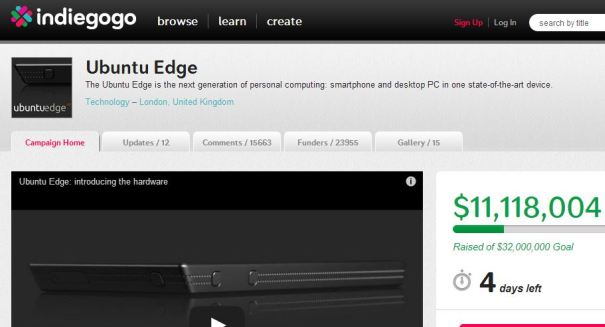
All told, Canonical ended up with roughly 27,500 backers and $13 million in the pot.
Earlier this week, the Ubuntu Edge, a new smartphone that was supposed to be developed by the company Canonical, had already broken crowdfunding records with its month-long campaign on the website IndieGoGo. Such a milestone occurrence would be cause for celebration for most users of crowdsourcing websites like IndieGoGo and the similarly-minded Kickstarter, but it’s not likely there will be much celebration in the offices of Canonical this week. According to a report from BBC News, the campaign may have broken records, but there was one target it missed: its own.
All told, Canonical ended up with roughly 27,500 backers and $13 million in the pot. The previous crowdfunding record, which was somewhere around $10 million, couldn’t compete with those extra millions. However, despite the overwhelming show of support and the generous donation amount, the joke may still be on Canonical. The IndieGoGo campaign had aimed to collect $32 million from 40,000 supporters, a goal that makes the actual numbers look like failures.
And failures they are. It’s a tradition of crowdfunding websites like IndieGoGo that all pledges are returned to their owners if the ultimate goal is not reached, leaving Canonical with nothing and actively killing the Ubuntu Edge.
So did Canonical simply make a major blunder and ask for more money than they could ever hope to receive? Perhaps, but according to Mark Shuttleworth, the company’s founder and CEO, if this campaign had asked for a smaller sum of money – $13 million, perhaps? – then either another campaign would have been necessary down the road or the phone’s features may have taken a hit.
Shuttleworth claimed that Canonical was attempting to cover the costs for both the development of the phone and the production of the handsets all in one fell swoop. Now, the CEO sees that $32 million was a nigh-impossible goal, and says that Canonical will have to go back to the drawing board to see if there is a viable future for the Ubuntu Edge. If another crowdfunding campaign is in the cards, Shuttleworth says that the fundraising goal will be markedly lower and that backers will only be asked to cover production costs. Where the development money will come from, he says, is still up in the air.
The Ubuntu Edge would have looked and acted much like other modern flagship phones, but would have boasted both mobile and desktop operating systems. The phone would have been able to connect to a monitor and a keyboard and more or less serve as a legitimate computer replacement.
Leave a Reply